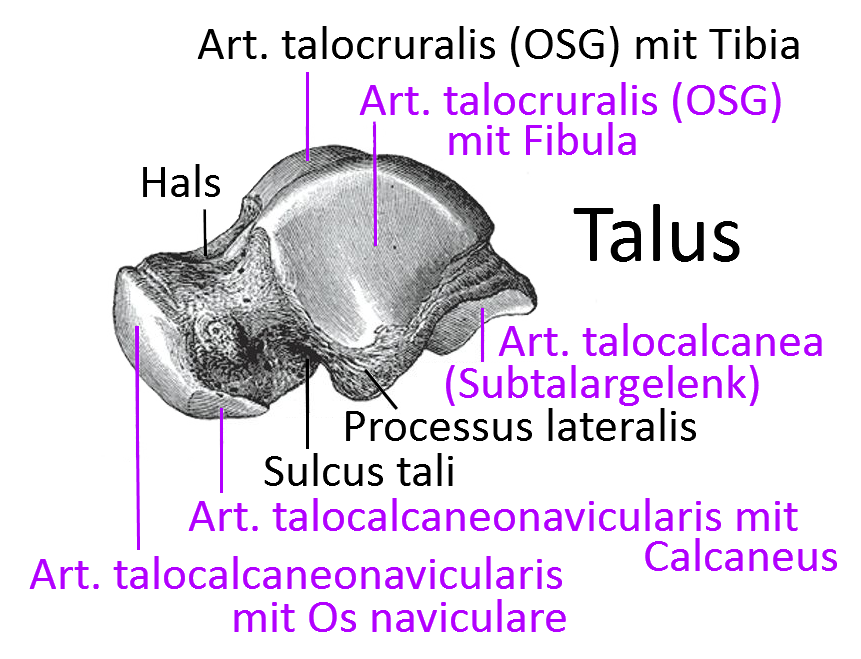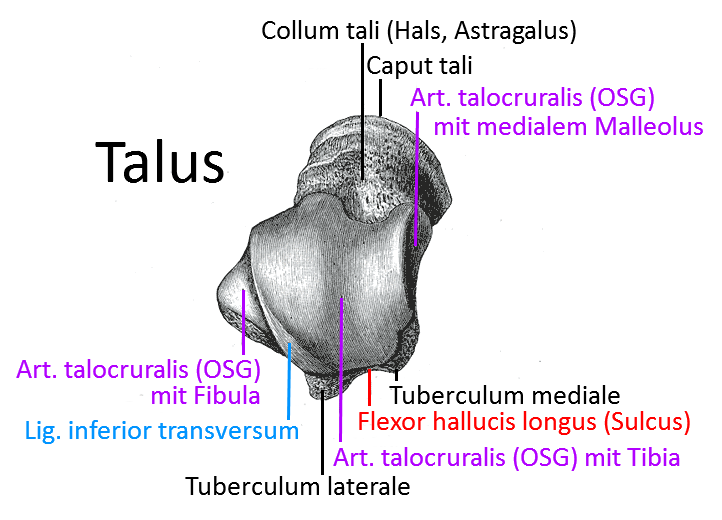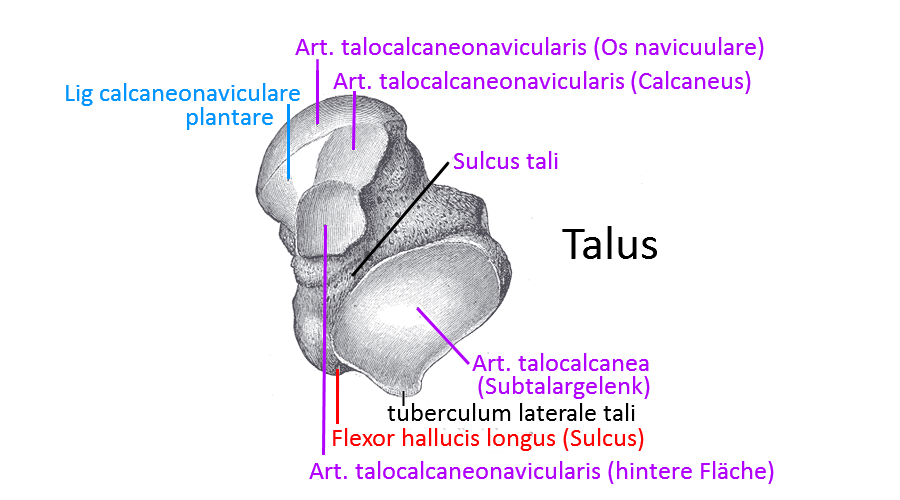Contents
Talus from lateral (slightly ventral-cranial)

Talus
The talus is located above the calcaneus and, like the calcaneus, is part of the tarsal bones. In the OSG (talocrural articulation ), the talus provides significant support for the load resting on the tibia; the corresponding joint surface is the largest in the OSG. In addition, the talus is surrounded medially by the medial malleolus, also part of the tibia, and laterally by the lateral malleolus, part of the fibula. Caudally, the talus has articular facets with the calcaneus (art. talocalcanea) and ventrally with the navicular bone (art. talocalcaneonavicularis). The OSG only allows dorsiflexion and plantar flexion of the foot, while the lower joints allow inversion and eversion, but not dorsiflexion and plantar flexion.
The talus does not have a single insertion for a muscle, neither origin nor insertion, but instead has extensive areas of cartilage. This is very atypical for a bone of the locomotor system and makes it appear as a kind of „bony meniscus“ between the tibia and the malleoli and, on the other hand, the calcaneus. As it bears the body weight – or dynamically a multiple of it – when standing and in all forms of locomotion on the feet, it is a particularly important bone. Fractures of the talus account for only 4% of all foot fractures and usually result from falls from a great height; however, a rapid trauma in the direction of plantar flexion with high kinetic energy can lead to a dislocation with accompanying ligament ruptures.
Corpus tali
The ventral part of the talus with the trochlea tali, which articulates with the facies articularis inferior of the tibia. The lateral malleolar facet of the talus articulates with the lateralmalleolus of the fibula. The medial malleolar facet articulates with the medialmalleolus of the tibia. These three articular surfaces are the distal part of the talocrural articulation. With the inferior facies, the talus articulates with the posterior calcaneal articularis of the calcaneus. The posterior facies has a groove for the tendon of the flexor hallucis longus.
Lateral tubercle / posterior process
Lateral to this groove is the posterior talar process (also known as the lateral tubercle). The lateral tuberosity, which is much more prominent than the medial tuberosity, is present in 13% of cases as an independent accessory bone of the trigonum.
Medial tuberosity
Medial to the groove in the corpus tali is a smaller medial tubercle.
Collum tali
The collum tali (neck) is the retracted middle part of the talus. The articular surface of the calcanea media lies on the underside of the collum tali.
Sulcus tali
The collum tali has an inferior talar sulcus that separates the anterior articular surfaces from the posterior articular calcaneal facies. In the calcaneus there is a corresponding groove (sulcus calcanei), through which a channel is created in which the talocalcaneal interosseous ligament lies . Ligaments are attached to the roughened medial side of the collum tali.
Caput tali
At the head of the talus lies the articular surface facies articularis calcanea anterior to the calcaneus and the surface facies articularis navicularis aligned with the cannon bone. The calcaneonavicular plantar ligament lies in the cartilaginous surface in between.
Joints
- Art. subtalaris / Art. talocalcanearis / subtalar joint / talocalcaneares joint
- Art. talocruralis(upper ankle joint)
- Art. talonavicularis (part of the anterior lower ankle joint / Chopart joint)
Articulated surfaces
In summary, the talus has articular surfaces with
- of the malleolar fork: trochlea tali, facies malleolaris lateralis, facies malleolaris medialis
- the calcaneus: facies articularis calcanea anterior, facies articularis calcanea media, facies articularis calcanea posterior
- the navicular bone Os naviculare: Facies articularis navicularis
Trochlea tali
The „talus roll“, the cranial articular surface of the talus, in which plantar flexion and dorsiflexion of the foot in the ankle joint occur, surrounded by the malleolar fork.
Pictures
Talus from cranial-ventral

Talus from caudal

